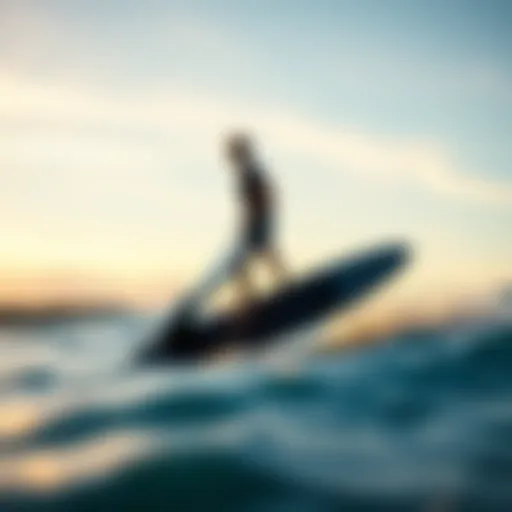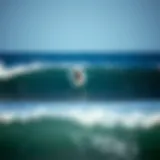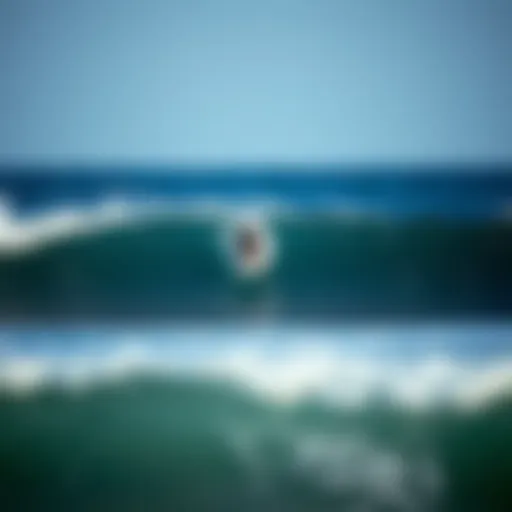Surfing Bali: A Comprehensive Exploration of Breaks
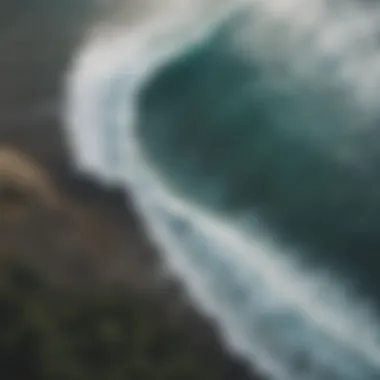

Intro
Bali, often dubbed the ‘Island of the Gods’, is more than just picturesque beaches and lush landscapes. It is a melting pot of surf culture that attracts wave riders from all four corners of the globe. With its varied surf breaks, Bali presents a unique opportunity for surfers of all levels—from the greenhorn paddling out for their first wave to the seasoned pro tackling the colossal swells at Uluwatu.
The surfing experience here is enriched by local traditions, vibrant ocean life, and the sheer beauty of the surroundings. Each break tells its own story, shaped by both nature's forces and the people who have come to embrace this thrilling sport. Therefore, understanding the beauty of surfing in Bali goes beyond just catching waves; it entwines with preserving the island’s unique ecology and appreciating the surf lifestyle deeply woven into Balinese culture.
Every surfer needs to pack more than just their board when heading to Bali's surf breaks. Gearing up with the right equipment and understanding the techniques can drastically improve the surfing journey. We’ll dive into the nitty-gritty of surf gear and essential skills needed to make the most of these glorious waves.
As waves propel from the Indian Ocean, they carve their way toward Bali's shores—let's explore what each break has to offer and how to maximize your experience while minimizing impact on this incredible environment.
Prologue to Bali as a Surf Destination
Bali stands as a beacon for surf enthusiasts across the globe. This island, with its enchanting landscapes and vibrant culture, has become synonymous with surfing. The waves here are not only world-class but also cater to a range of skill levels, making it a hot spot for both novice and seasoned surfers. Bali's natural beauty is matched only by the magnetic surf culture that thrives within it.
Choosing to surf in Bali goes beyond the act of riding waves. It encompasses the experience of immersing oneself in a rich cultural tapestry woven through surfing. The island's surf breaks offer more than just challenging conditions; they promise a journey into the soul of Bali. From the laid-back beaches of Kuta to the rugged cliffs of Uluwatu, each break tells a story of local traditions and the evolution of surf culture.
Historical Context of Surfing in Bali
The roots of surfing in Bali can be traced back several decades. In the 1930s, surfing was introduced to the island by American and Australian surfers seeking the perfect waves. However, it was not until the 1970s that surfing began to grow significantly in popularity. With its warm waters and consistent swells, Bali quickly became a revered destination within the international surfing community.
This growth did not happen without a musical backdrop: local legends such as the late surfer and filmmaker, John Perrett, played a crucial role in showcasing Bali to the outside world through films and photographs. As surf tourism burgeoned, so did the development of surf schools and rental shops. Today, Bali hosts a multitude of surf competitions, each contributing to its rich historical narrative.
The Evolution of Surf Culture in Bali
The surface of Balinese culture is a reflection of its diverse history. Surfing is now seen as not just a sport but a lifestyle, intertwined with the local way of life. Many locals have taken up surfing, practicing traditional rites of passage through the sport. With surf schools teaching thousands of newcomers every year, it’s clear that the sport’s influence has broadened far beyond its shores.
Surfing Culture and Community
Bali’s surf community thrives on a shared passion for the ocean and waves. This community extends beyond surfers; it includes local businesses and artisans who appreciate the sport and its value to the culture of the island. Cafés showcasing surf art, shops selling hand-crafted boards, and eco-friendly products reflect a collective commitment to preserving Bali’s beauty and the surfing lifestyle.
In addition, the competitive nature of surf culture here encourages unity among surfers. Regardless of skill level, there’s a profound respect for the ocean and the surf spots it provides. Locals are often seen mentoring tourists, creating a unique bond that strengthens the connections within the community. This kind of camaraderie distinguishes Bali from other surf destinations, where the surf scene can sometimes feel more competitive than collaborative.
It is this synergy among surfers, from professional athletes to enthusiastic beginners, that makes Bali a standout surf destination.
Overall, Bali is not just a place to ride waves; it is a canvas of history, culture, and community that has positioned it as one of the top global surf destinations. For anyone looking to understand surfing in Bali, grasping its deep-seated heritage and community involvement is essential.
Understanding Bali's Oceanography
Bali's appeal as a surfing hotspot is deeply intertwined with its oceanography. The physical features of the ocean surrounding this island influence wave formation, conditions, and the overall surf experience. Gaining an understanding of these elements is critical for surfers seeking to maximize their time on the water. The dynamic interplay of wind, tide, and season dictates the types of waves one can expect throughout the year.
Wave Formation and Conditions
The process by which waves form is complex, yet fascinating. Waves at Bali's surf breaks primarily arise from two sources: local winds and distant storms. When the wind blows over the ocean's surface, it generates ripples that eventually grow into waves. As these waves travel and converge upon the coast, their energy builds up, creating powerful swells. In Bali, the best waves typically show up during the dry season, from April to September, when consistent winds and swells converge.
The direction of swell is another vital factor to consider. Swells that approach from the Indian Ocean produce some of the most memorable surf experiences. For example, Uluwatu and Padang Padang benefit greatly from these swells, while western beaches like Kuta can showcase waves from different angles, presenting unique surfing conditions.
"Waves are not just water; they are a mood, a rhythm, a promise of adventure waiting to unfold."
Local Climate and Seasons
Bali's climate significantly impacts the surf conditions. The island experiences two primary seasons: the dry season and the rainy season. During the dry season, the weather is predominantly sun-soaked, fostering ideal surfing conditions. You can expect less rain, lower humidity, and a lively social surf scene. Meanwhile, the rainy season, which typically lasts from November to March, brings unpredictable weather, strong winds, and potential storms. However, don't let that deter you; some believe that the rainy season can yield hidden gems for adventurous surfers who know where to look.
A few patterns worth noting:
- April to September (Dry Season):
- October to March (Rainy Season):
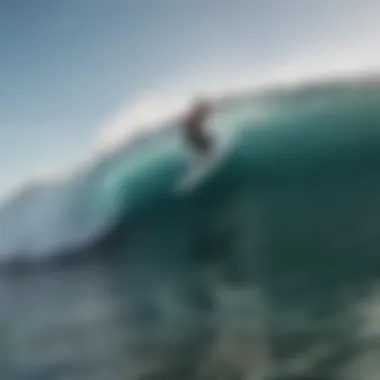

- Consistent and powerful swells.
- Ideal conditions for all skill levels, with clear skies dominating the vistas.
- More variables at play, leading to unpredictable surf conditions.
- Less crowded spots, which could mean a chance for solitude and exploration.
In summary, understanding the local oceanography of Bali sets the stage for a well-rounded surfing experience that caters to various skill levels, preferences, and ambitions. By aligning one's practice with the conditions and seasonal changes, you'll be better equipped to ride some of the most thrilling waves that Bali has on offer.
Overview of Popular Surf Breaks in Bali
When it comes to surfing, Bali stands out not just for its breathtaking scenery but also for its diverse range of surf breaks. This guide is dedicated to unraveling the nuances of these surf spots, each one offering unique opportunities for enjoyment and challenge. Understanding the popular breaks enhances both the novice and the seasoned surfer's experience, ensuring they pick the right spot according to their skill level and surfing style. Here, we highlight key attributes of Bali's surf breaks as well as consider the atmosphere and local culture each area lends to the surfing experience.
With its rich surfing history, Bali plays host to various surf competitions that attract athletes worldwide. This has nurtured a vibrant community of surf enthusiasts who share knowledge and tips, making it an open hub for aspiring surfers to hone their skills while connecting with fellow wave riders.
Kuta Beach: The Beginner's Paradise
Kuta Beach offers an inviting entry point for those new to surfing. As one of Bali's most popular surf spots, it welcomes beginners with consistent small waves and sandy bottoms. Instructors abound, and surf schools are dotted along the beach, making it easy to find guidance. With the sun setting over the ocean, Kuta becomes a scene of laughter and joy as newcomers celebrate their first successful rides.
However, despite its amiable atmosphere, surfers should keep in mind the possible crowds. Mornings during high season can attract many surfers, but showing patience and perseverance can lead to a fulfilling experience. Safety is always a priority, and there's enough room in the water for everyone to learn and grow.
Uluwatu: A Challenge for Advanced Surfers
On the opposite end of the spectrum lies Uluwatu, famous for powerful waves that demand respect and skill. The surf breaks here are not for the faint-hearted. With steep drops and strong currents, only experienced surfers should attempt the waves that Uluwatu has to offer.
Uluwatu's cliffs and scenic views create an electric atmosphere. As surfers navigate the challenging lineup, they get rewarded not only with the thrill of riding some of the world’s best waves but also with breathtaking sunset scenery.
"Uluwatu brings out the best in you. It's not just about the waves; it's about pushing your abilities to new heights."
Canggu: A Growing Hotspot
Canggu has gained immense popularity among surfers in recent years—it’s bustling with trendsetters and serves as a central hub for young and adventurous surfers. The breaks here appeal to all levels, but the charm of Canggu lies in its adaptability.
With both beach and reef breaks, surfers can shift spots based on their comfort and ability. Seminyak Beach in Canggu is more forgiving, whereas spots like Echo Beach present more of a challenge. Keep an eye out for vibrant beach clubs and local eateries enhancing the area's appeal, making Canggu not just a surfing destination but a lifestyle choice.
Padang Padang: The Iconic Right-Hander
Padang Padang has secured a place in surf lore as an iconic break. Known for its fast and hollow right-hand waves, it requires skill, but provides one of the most exhilarating experiences for those who dare take it on.
The beach itself is a hidden gem, nestled between cliffs with a small entrance leading down. This gives it a unique charm, attracting surfers and photographers alike. The wave usually gets best during mid to high tide, creating a canvas for riders to showcase their skills.
In summary, Bali's surf breaks cater to a wide array of surfers, each with their personal preferences and skill levels. From the soft rolls at Kuta to the challenging barrels of Uluwatu, there’s something for everyone. Familiarity with each break leads to deeper respect and appreciation for the ocean—a valuable lesson for all who step into the waves.
Identifying Surf Breaks by Skill Level
When one heads to Bali, the myriad of surf breaks might feel like a candy store to a surfer. Flavors abound—each wave, each swell promising a different experience. But not all surfers are created equal, and unlike a uniform piece of candy, those waves cater to a variety of skill levels. Understanding the nuances of surf break classifications—beginner, intermediate, and advanced—goes beyond mere categorization. It's about ensuring safety, enhancing learning, and celebrating the art of riding waves without getting in over one's head.
Breaks for Beginners
For novice surfers, Bali is akin to having a cheat sheet for mastering the basics. The right environments can serve as a launchpad for building confidence. Kuta Beach is often hailed as the holy grail for beginners; its forgiving waves roll in mellow and consistent, making it perfect for those taking their first steps on a board. Here are aspects that make Kuta, and other beginner-friendly spots, noteworthy:
- Gentle Waves: Waves here are not only less powerful, but they also break in a way that allows beginners to catch them without a struggle.
- Surf Schools: The area is dotted with numerous surf schools, offering lessons and rental equipment, which eases the process.
- Community Support: With many learners around, one can feel a sense of camaraderie, and seasoned surfers often offer tips.
In addition to Kuta, Legian Beach and Seminyak serve fine alternatives, with similar wave characteristics. Here, it's really about honing the essential techniques: paddling, standing up, and most crucially, falling with grace.
Intermediate Surfing Areas
Once novice surfers feel a bit steadier on the board, the thirst for the next challenge beckons. Intermediate breaks present an opportunity to refine skills—think of it as upgrading from a sparring session to an actual match. Spots like Canggu and Bingin Beach cater well to the growing competency among surfers, offering the adrenaline rush without excessive risk. Key points include:
- Varied Wave Heights: Intermediates can expect waves of moderate size, perfect for practicing turns and style variations.
- Less Crowded: Areas like Canggu offer periods where the surf isn’t swamped with learners, allowing more uninterrupted practice.
- Diverse Conditions: The mix of reef and beach breaks means surfers can experience different types of waves in a single outing.


Bingin Beach, known for its hollow waves, challenges surfers to improve paddle strength and wave positioning, which are vital skills that push their surfing ability further.
Advanced Surf Spots
For those with a hefty trophy collection and the battle scars to match, Bali's pitch for advanced surfers is nothing short of legendary. Waves at spots like Uluwatu and Padang Padang cater to seasoned surfers who thrive on power and unpredictability. An outline of these revered areas includes:
- Challenging Conditions: These waves pack a punch—strong currents and larger swells require sharp reflexes and surgical precision.
- Reef Breaks: While breathtaking, the reefs can add an element of danger. Skill is essential, but so is respect for the ocean.
- Local Knowledge: Understanding the tide and swell patterns is pivotal, as conditions can change faster than you can say "surf's up!"
To sum it up, advanced spots are where surfers can navigate their prowess and bravery, pushing limits in an environment that demands respect for the craft and the ocean.
Understanding your skill level is crucial to enhancing your surfing experience and safety. Choose your surf spots wisely, and every wave will feel like a victory!
Environmental Considerations
Understanding the environmental impact on surf breaks in Bali is crucial for surfers and the broader community alike. This topic unveils essential elements regarding the sustainability of the region's surf conditions, the delicate balance of ecosystems, and the importance of both proactive and reactive measures to maintain the surfing experience. By looking into these considerations, both visitors and locals can cultivate an appreciation that transcends the thrill of riding waves, fostering a more sustainable surf culture.
Impact of Climate Change on Surf Breaks
Climate change increasingly weighs on the surf breaks around Bali. With rising sea levels, ocean temperatures fluctuate, resulting in altered wave patterns. These changes can affect not just the quality of the surf but also the safety of participating surfers.
- Erosion of Beaches: Some locations, such as Kuta Beach, have seen beach erosion as climate change intensifies storms and sea levels rise. This erosion alters not only where surfers gather but how waves break.
- Coral Bleaching: Warmer seas lead to coral bleaching, which disrupts the marine ecology on which local surf breaks depend. Healthy reefs are essential in shaping wave formation; thus, their degradation translates into less reliable waves.
As > Bali relies heavily on tourism, maintaining surf breaks is essential for the economy, making awareness around climate impacts all the more important.
Pollution and Conservation Efforts
As Bali attracts surf enthusiasts from every corner of the globe, it bears the brunt of pollution. The influx of visitors sometimes overwhelms the local ecosystem, leading to a pressing challenge. With plastic waste and sewage management becoming significant concerns, the surfing community plays a part in advocating for the preservation of this paradise.
- Plastic Pollution: The accumulation of plastic waste along beaches not only hampers the beauty of the surroundings but also poses risks to marine life. Surfers often witness firsthand the impact of debris in the waters they ride.
- Community Initiatives: Various local organizations have kicked off clean-up drives aimed at maintaining the pristine quality of Bali’s beaches and oceans, encouraging surfers to participate. Initiatives such as using biodegradable wax for surfboards have also seen growing traction.
- Legislation and Enforcement: The local government is making strides to enforce laws against littering and dangerous waste disposals. These measures can enhance conservation efforts but require community backing.
In a nutshell, tackling pollution and spearheading conservation projects is essential for preserving Bali's surf culture. Awareness, education, and collective action among surfers can generate a ripple effect towards safeguarding the environment, ensuring that future generations can enjoy the same breathtaking surf breaks.
Preparation for Surfing in Bali
Before hitting the surf, having a good grasp of what you need to keep in mind is vital. Preparation for surfing in Bali addresses everything from essential gear to the right surf school. It’s not just about the sport, it’s about what enhances your experience in this beautiful place. For many, Bali offers that perfect blend of challenging waves, warm weather, and friendly locals. But to truly enjoy it, understanding various preparation elements is crucial.
Essential Gear and Equipment
Your surf journey begins with the right equipment. A few items will make your experience much smoother and more enjoyable. Here are some core essentials:
- Surfboard: Depending on your skill level, the type of board you need varies. Beginners might lean towards a longboard for stability, while more advanced surfers might prefer shorter, more maneuverable boards like a shortboard.
- Leash: This piece of equipment keeps your board attached to you. Losing a board can not only be costly but can also pose a risk to other surfers.
- Wetsuit: While Bali's waters are typically warm, depending on the season, you may want to wear a wetsuit for sun protection and warmth, especially in the mornings and evenings.
- Sunscreen: Look for reef-safe options. You're in paradise, and protecting your skin from harmful rays is a must.
- Accessories: Consider bringing items like surf wax, a surf cap, and water shoes, depending on your comfort and the specific break you choose.
All these pieces work together to create a safer, more enjoyable surfing experience. Plus, having good gear can quickly enhance your skills.
Choosing the Right Surf School
For those not well-versed in surfing or first-timers, selecting a surf school is a pivotal step. The right surf school can make all the difference in how quickly you progress. Here are some factors to consider:
- Reputation: Look for schools with positive reviews, focused on teaching and safety. Check out sites like Reddit or Facebook for real opinions by other surfers.
- Instructor Experience: It’s always a good sign if the instructors are certified and have a strong surfing background. They can offer insights beyond basic paddling techniques, like understanding ocean conditions.
- Group Size: Smaller groups often mean more personalized attention, allowing you to get more out of each lesson.
- Facility Offerings: Some schools offer more than just lessons. They might provide gear rentals, workshops, or even yoga sessions, giving you a well-rounded experience.
- Location: Make sure the school is located near suitable breaks for your skill level, so you have the best chance of catching waves and learning effectively.
Choosing the right school not only helps you learn how to ride a wave but also immerses you in the local surf culture. It gives you a taste of community and can open doors to making lifelong connections.
Understanding the right preparation sets the tone for an incredible surfing adventure in Bali. With the right gear and education, every surfer can unlock the secrets of this surf haven.
Cultural Awareness and Etiquette
Understanding cultural awareness and etiquette in Bali's surfing community is as crucial as catching the perfect wave. Bali boasts a rich tapestry of traditions and lifestyles shaped by its Hindu roots and close-knit communities. When surfers immerse themselves in this culture, they not only enhance their own experience but also foster goodwill with locals.
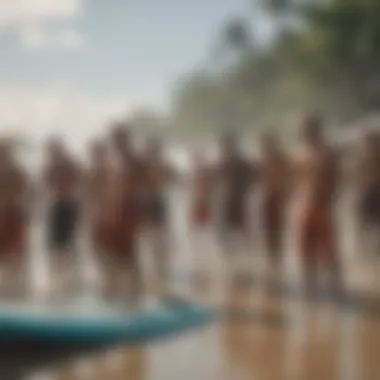

Respecting Local Traditions
Bali is not just a surf haven; it is a place where customs run deep. The island is home to many religious and cultural practices that should be respected by visitors. For instance, observing traditional ceremonies is vital. Surfers should be mindful not to disrupt religious events or visit sacred sites while in board shorts or wet suits, as this may be seen as disrespectful.
Engaging with the community is another way to honor local customs. Active participation in beach clean-ups or local surfing events can create bonds that bridge cultures. Listening to the stories from local surfers can provide insight into the rich history of the island's surf scene. Establishing rapport not only strengthens community ties but also allows surfers to learn valuable and often untold knowledge about the surf spots.
- Always notice any signs indicating sacred areas or times for ceremonies.
- Be attentive to local surfers and follow their lead regarding etiquette and behavior.
- Respect private property and local businesses; ask for permission where needed.
Understanding Surf Etiquette
Knowing the unwritten rules of surfing is essential when catching waves in Bali. Each surf break has its own set of expectations that surfers are expected to follow.
Paddling out: Always yield to those already riding the wave. This principle is foundational, ensuring every surfer's safety and enjoyment. If you find yourself in a crowded lineup, patience is paramount.
Taking Turns: The buzz of the lineup can be intimidating. It’s important to wait your turn and not drop in on someone else's wave. Dropping in can escalate tensions and portrays a lack of respect towards fellow surfers.
- Communicate clearly with hand signals to indicate your intentions.
- If you fall, get out of the way quickly to avoid accidents.
- A simple nod or smile often goes a long way in fostering a friendly atmosphere.
Understanding and practicing surf etiquette in Bali not only elevates individual surfing experiences but also nurtures a harmonious relationship between surfers and the vibrant local culture.
The Community Aspect of Surfing in Bali
In Bali, surfing transcends mere sport; it embodies a rich culture, shared identities, and connections through the waves. The community aspect of surfing here plays a pivotal role in fostering relationships, promoting camaraderie, and nurturing a love for these mesmerizing oceans. It’s not just about riding waves; it’s about riding the wave of a lifestyle that binds individuals from various backgrounds, turning strangers into friends.
Local Surfer Networks and Events
Bali is an epicenter for surfing, attracting enthusiasts from around the globe. The local surfer networks are robust, ranging from informal meet-ups at the beach to organized events that galvanize the surf community.
These networks thrive through social media platforms like Facebook and Instagram, where local surf shops and schools update followers about competitions, surf clean-ups, and community gatherings. Events such as the Bali Pro Surf Championship and the local surf festivals draw large crowds, not just to compete, but to foster a deeper sense of belonging among surfers. Participating in these events can be a great way to make connections and even pick up local tips.
Local surfers often enjoy a ritual of gathering after a surf session; they share stories over a cold Bintang beer, discussing wave conditions and the best spots to hit next. Such gatherings help newcomers acclimate and encourage the locals to share their knowledge of the waves and surf culture.
Connecting with Fellow Surfers
For both novice and veteran surfers, forming connections is key to enhancing the experience. The welcoming vibe in Bali makes it easy to approach fellow surfers.
Here are some benefits of engaging with the community:
- Shared Knowledge: Fellow surfers can impart valuable insights about wave patterns, tides, and hidden gems off the beaten path.
- Mentorship Opportunities: Experienced surfers often take beginners under their wing, offering guidance that cannot be found in textbooks or tutorials.
- Building Friendships: The waves are just a part of the experience; establishing bonds with others who share the passion deepens the significance of each surf session.
- Social Responsibility: Surfers often come together for beach clean-up events, instilling a sense of duty toward the ocean that they love.
"Surfers are like a family; we're all in this for the same reason: the love of the ocean. To ride or not to ride, we all understand the thrill and the responsibility it brings."
In Bali, surfing nurtures a sense of community that enriches the experience and places each rider in a larger narrative. Whether it's through local networks or shared experiences at surf events, the connections made in Bali go beyond the waves, creating lasting bonds that echo the rhythm of the sea.
Finale: The Allure of Bali's Surf Scene
Bali stands out as a premier destination for surfers, drawing enthusiasts from around the globe for its irresistible charm and diverse wave offerings. This conclusion encapsulates the essence of surfing in Bali, reflecting key elements that contribute to its status as a surfing haven.
One of the main attractions is the sheer variety of surf breaks available, catering to all skill levels. From the gentle swells at Kuta Beach perfect for beginners to the challenging barrels at Uluwatu for seasoned surfers, each location offers something distinct. The ability to find the right break for one’s level not only enhances the surfing experience but also encourages safe practices in the water.
The culture surrounding surfing in Bali is another magnetic draw. Local surfer communities embrace and celebrate their passion, intertwining it with Balinese traditions and lifestyles. As surfers paddle out, they're not just riding waves; they're partaking in a cultural experience that offers a deeper connection to the island. Surfing events and community gatherings further solidify the bond between locals and tourists, creating lasting memories and friendships.
Environmental considerations play a pivotal role in maintaining the allure of Bali's surf scene. With increasing awareness of the impact of climate change and pollution threats, there’s growing momentum behind conservation efforts. Surfers have the unique opportunity to be stewards of these precious breaks, advocating for sustainable practices that protect both the ocean and the local environment. This growing consciousness enhances the sense of responsibility among surfers and fosters a community-focused approach.
The preparation involved in surfing Bali is vital, ranging from understanding local customs and surf etiquette to selecting the right gear. Such preparatory steps elevate the entire experience, allowing surfers to focus on enjoying their time in the water rather than navigating through the logistics.
In summary, Bali’s surf scene weaves together a perfect tapestry of adventure, cultural experiences, and environmental awareness. The blend of thrilling waves, community spirit, and a commitment to preservation captures the hearts of surfers, ensuring that their connection to this beautiful island endures well beyond the ride.
"Surfing isn’t just a sport; it’s a lifestyle that fosters bonds, embraces culture, and demands respect for our oceans."
Final Thoughts on Surfing in Bali
As you consider your surfing journey in Bali, it’s essential to reflect on what makes this destination unique. Embracing the vibrant culture, respecting local etiquette, and appreciating the environmental nuances deepen your experience. Whether you come to challenge yourself on the serious breaks or to unwind on gentle waves, Bali promises an adventure worth cherishing.
Take the time to connect with local surfers, understand the ecosystems around you, and relish the ride. Each wave caught is not just a personal achievement but a shared experience in a lively, colorful community that welcomes you with open arms. Bali is not merely a location on the map; it’s a thriving surfing paradise that leaves an imprint on anyone willing to immerse themselves fully.









